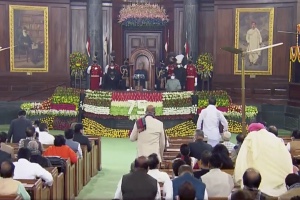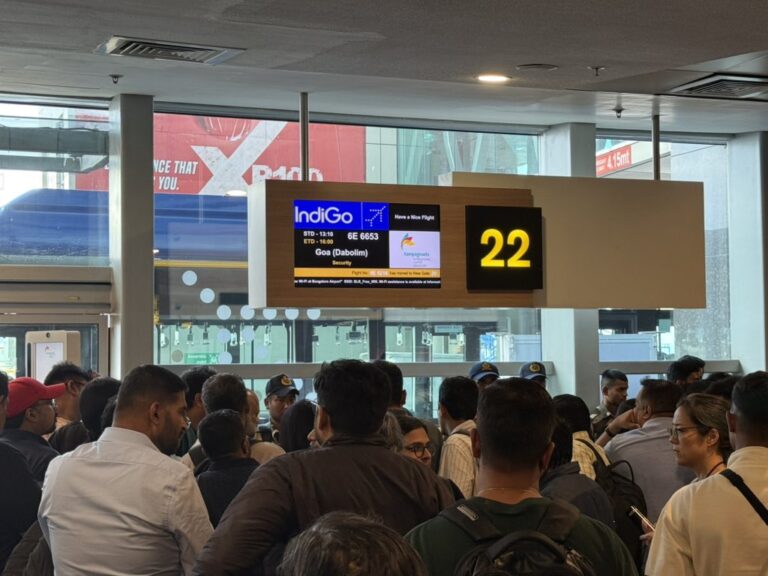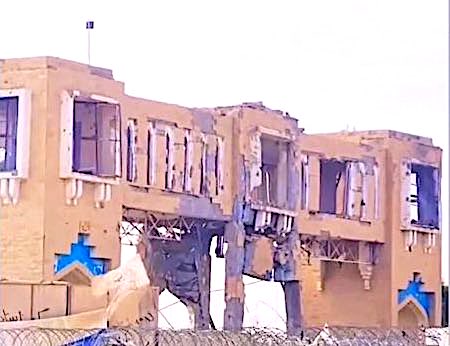
New Delhi: COVID-19 pandemic comprised a major part of President Ram Nath Kovind’s address to both Houses of Parliament at the commencement of the Budget Session here today. Referring to the ongoing Azadi Ka Amrit Mahotsav to celebrate the 75th year of Indian Independence, the President said the challenging period of Corona “inspired us to achieve our goals at the fastest possible pace”.

Following are the key points of the President’s address:
CORONA
- An example of India’s capability in the fight against Covid-19 is evident in the ongoing Covid vaccination program. India has surpassed the record of administering more than 150 crore vaccine doses in less than a year. Today India is among the leading countries in the world with the highest vaccine doses administered.
- Today, more than 90 percent adult citizens of the country have received the first dose of the vaccine, whereas more than 70 percent have been administered both the doses. The government is also reaching out to the rest of the population through the ‘Har Ghar Dastak’ campaign. Adolescents in the age group of 15 to 18 years have also been included in the vaccination program from this month. Precautionary dose for the front-line workers and senior citizens with co-morbidities has also been started.
- The efforts of the country are not limited to addressing the immediate challenges in the fight against Covid pandemic. Government is developing far-reaching solutions which would be effective and useful in future also. The launch of Pradhan Mantri Ayushman Bharat Health Infrastructure Mission with an outlay of Rupees 64,000 crore is a commendable example. This will not only help in meeting the current health requirements, but will also prepare the country for any future crises.
- More than 80,000 health and wellness centres and crores of Ayushman Bharat cards have helped the poor immensely in getting treatment. Government has reduced the cost of treatment by providing affordable medicines through more than 8,000 Jan Aushadhi Kendras.
- The Indian pharma sector has also proved its mettle during the Corona period. Presently, products of Indian pharma companies are reaching more than 180 countries.
- The country used to export AYUSH products worth Rupees 6,600 crore in 2014. This export has now increased to more than Rupees 11,000 crore. India is going to establish the world’s first ‘WHO Global Centre of Traditional Medicine’.
- Government is providing free ration to each poor household every month under the Pradhan Mantri Garib Kalyan Anna Yojana. This is the world’s largest food distribution program with an outlay of Rupees two lakh sixty thousand crore reaching out to 80 crore beneficiaries for 19 months. Being fully sensitive to the present circumstances, the government has extended this scheme till March 2022.
DIGITAL BANKING
- Transactions worth more than Rupees 8 lakh crore have taken place in the country through UPI in December 2021. This is a clear example of how fast our people are adopting technology and rapid change.
- The impact of Jan Dhan-Aadhaar-Mobile or JAM trinity is visible. With more than 44 crore poor people joining the banking system, crores of people benefitted from direct cash transfer during the pandemic.
WELFARE SCHEMES
- Under the PM-Sva-Nidhi scheme for enhancing the self-esteem of the poor and protection of their livelihood during the Corona period, more than Rupees 2900 crore have been provided to 28 lakh street vendors. The government is also connecting these street vendors with online food delivery companies. Further, government has started the e-SHRAM portal to protect the interests of labourers and more than 23 crore workers have joined it so far.
HOUSING
- More than two crore pucca houses have been provided to the poor under the Pradhan Mantri Awas Yojana and under the Pradhan Mantri Awas Yojana – Gramin, 1 crore 17 lakh houses have been approved at a cost of about Rupees one and a half lakh crore in the last three years.
DRINKING WATER
- Nearly six crore rural households have been provided tap water connection under the Jal Jeevan Mission, launched with the aim of ‘Har Ghar Jal’.
RURAL PROPERTY
- The Svamitva scheme, launched to provide property documents to people in rural areas, is also an extraordinary initiative. So far, more than 40 lakh property cards have been issued in 27,000 villages under this scheme. These property cards are not only preventing disputes but are also assisting rural population in accessing banking support.
AGRICULTURE
- Farmers produced more than 30 crore tonnes of food grains and 33 crore tonnes of horticulture produce in 2020-21. The government procured 433 lakh metric tonnes of wheat during the Rabi season benefiting about 50 lakh farmers. A record quantity of about 900 lakh metric tonnes of paddy was procured during Kharif season, benefiting 1 crore 30 lakh farmers.
- Agriculture exports registered a growth of more than 25 percent in the year 2020-21, and have reached nearly Rupees 3 lakh crore.
- Domestic production of honey has reached 1 lakh 25 thousand metric tonnes in 2020-21, an increase of about 55 percent compared to 2014-15. Export volume of honey has also grown by more than 102 percent as compared to 2014-15.
- In order to ensure remunerative prices to farmers for their crops, the government launched Kisan Rail Seva and during the Corona period, Indian Railways operated over 1,900 Kisan Rails on more than 150 routes to transport perishable food items like vegetables, fruits and milk, thereby transporting about 6 lakh metric tonnes of agricultural produce.
FARMERS’ UPLIFTMENT
- Under the PM-Kisan Samman Nidhi, Rupees 1 lakh 80 thousand crore have been provided to more than 11 crore farmer families. The small farmers of the country, who constitute 80 percent of the farmer-community, have also benefited from the new changes in the crop insurance scheme. More than Rupees one lakh crore have been given as compensation to about eight crore farmers since these changes were introduced.
- For developing infrastructure required near farmlands, thousands of projects have been approved under the Agriculture Infrastructure Fund having a corpus of Rupees one lakh crore.
- In order to ensure self-sufficiency in edible oil, government has also launched the National Mission on Edible Oils – Oil Palm with an outlay of Rupees 11,000 crore. Government is also making special efforts like organic farming, natural farming and crop diversification.
- Year 2023 has been declared by the United Nations as the International Year of Millets. The government will celebrate the International Year of Millets on a large scale with farmers, Self-Help Groups, FPOs, food industry and the common citizen.
RAIN WATER CONSERVATION
- Special campaigns are being implemented for creation of rain water harvesting infrastructure and restoration of traditional water sources in the country. Sixty-four lakh hectares of land with irrigation facilities has also been developed in the country with the help of various projects under the Pradhan Mantri Krishi Sinchayee Yojana and Atal Bhu-jal Yojana. The government has also taken forward the plans for interlinking of rivers. Recently, the Ken-Betwa link project to be completed at a cost of Rupees 45,000 crore has also been approved. This project will be helpful in ending the water crisis in Bundelkhand.
WOMEN’S EMPOWERMENT
- Women are playing an increasingly important role in providing impetus to rural economy. Banks have extended financial help to the tune of Rupees 65,000 crore to more than 28 lakh Self-Help Groups in 2021-22. This is four times the amount extended in 2014-15. The government has also provided training to thousands of members of the women self-help groups and made them partners as ‘Banking Sakhi’. These women are delivering banking services to rural households at the doorsteps.
- Women’s empowerment is one of the top priorities of my government. We are all witness to the success of Ujjwala Yojana. Entrepreneurship and skills of women have been promoted through the “Mudra” scheme. “Beti Bachao, Beti Padhao” initiative has yielded many positive results, and there has been an encouraging improvement in the number of girls enrolled in schools. Treating sons and daughters as equals, the government has also introduced a Bill to increase the minimum age of marriage for women from 18 years to 21 years at par with men.
- The government has made a beginning to liberate the society from the manifestly arbitrary practice of Triple Talaq by making it a criminal offence. Restrictions on Muslim women from performing the Haj only with Mehram have also been removed. While about three crore students from minority communities were provided scholarships prior to 2014, the government has provided scholarships to 4.5 crore such students since 2014, leading to a significant reduction in the school dropout rate of Muslim girls and an increase in their enrolment.
- A provision has also been made for Gender Inclusion Fund in the National Education Policy to promote learning capability among girls. All the existing 33 Sainik Schools have started admitting girl students. The government has also approved the admission of women cadets in the National Defence Academy. The first batch of women cadets will enter the NDA in June 2022. With the policy decisions and encouragement of the government, the number of women personnel in various police forces has more than doubled as compared to 2014.
EDUCATION
- The new National Education Policy across the country will give shape to the resolve and potential of Atmanirbhar Bharat. Local languages are also being promoted through the National Education Policy. Emphasis is being laid on conducting important entrance examinations for undergraduate courses in Indian languages as well. This year, 19 engineering colleges in 10 states will start teaching in six Indian languages.
- Under the Skill India Mission, more than 2 crore 25 lakh youth across the country have been skilled through ITIs, Jan Shikshan Sansthans and Pradhan Mantri Kaushal Kendras. Many changes have also been made in the UGC regulations to link skills with higher education.
- In the battle against Corona, six special training programs related to health care have been launched under the Skill India Mission to help the health care sector.
- Eklavya Residential Model Schools are being expanded to every tribal majority block for the education of tribal youth. These schools will empower about three and half lakh tribal youth.
SPORTS
- In order to improve India’s performance in the Olympics and sports, the Central Government along with the state governments is setting up hundreds of Khelo India Centres in the country. The government has also established Centres for Disability Sports in Gwalior with modern facilities to provide training to Divyang youth in para sports.
DISABILITY
- Accessibility, equality and a dignified life for Divyang people is any society’s collective responsibility. In this direction, Sugamya Bharat Abhiyan is a symbol of our national sensibility. The country is implementing several programs – from providing free assistive devices to Cochlear Implant surgery – in order to transform the lives of Divyang people. Under these programmes, more than 25 lakh assistive devices have been provided to Divyang people so far and about 4,000 successful Cochlear Implant surgeries have been performed. Taking these efforts forward, the government has also established the National Institute of Mental Health Rehabilitation in Madhya Pradesh. A 10,000-word Indian Sign Language Dictionary has also been developed for the future of Divyang youth.
START UP INDUSTRY
- Since 2016, sixty thousand new start-ups have been established in 56 different sectors in our country. More than six lakh jobs have been created by these start-ups. In 2021, during the Corona period, more than 40 unicorn start-ups have emerged in India, each with a minimum market valuation of Rupees 7,400 crore.
- The cost of internet connectivity and price of smartphones in India today are among the cheapest in the world. This has hugely benefitted the young generation. India is also working with great pace on 5G mobile connectivity, which will open doors to new opportunities. India’s efforts on semiconductors will significantly benefit the start-up ecosystem. The government has taken many policy decisions and opened up several new sectors so that the youth can benefit from rapidly changing technology. Through the Start-ups Intellectual Property Protection Program, the government has simplified and accelerated the processes related to patents and trademarks. As a result, nearly 6 thousand patents and more than 20 thousand trademarks have been applied for in this financial year.
ECONOMY
- India has again emerged as one of the fastest growing economies in the world. GST collection has consistently remained above Rupees one lakh crore during the last several months. Inflow of 48 billion dollars in the first seven months of the current financial year is a testimony to the belief the global investor community has in India’s growth story. India’s foreign exchange reserves today exceed 630 billion dollars. India’s exports are also growing rapidly, breaking several past records. During April to December 2021, the country’s goods-exports stood at 300 billion dollars or more than Rupees 22 lakh crore, which is one and a half times more than the corresponding period of 2020.
- The government has launched 14 key Production Linked Incentive (PLI) schemes with an outlay of more than Rupees 1 lakh 97 thousand crore to fully realize the potential of the manufacturing sector and to create new opportunities for the youth. These PLI schemes will not only help transform India as a global manufacturing hub but also create over 60 lakh jobs. The domestic mobile manufacturing sector is a shining example of the success of the PLI scheme. Today India has emerged as the second largest mobile phone manufacturer in the world, generating lakhs of jobs for the youth.
- In order to develop the country as a global leader in the field of electronics and technology hardware, the government has also recently announced a package of Rupees 76,000 crore for silicon and compound semiconductor fabrication, display FAB, chip design and related ventures.
- The government has approved seven Mega Integrated Textile Regions and Apparel Parks with an investment of about Rupees 4,500 crore. This will facilitate integrated textile value chain. These mega textile parks will attract both Indian and foreign investors, and create lakhs of new employment opportunities.
BUSINESS & INDUSTRY
- Along with large companies, small and medium enterprises have a critical role in India’s prosperity. MSMEs have been the backbone of economy, and a driver of Atmanirbhar Bharat. In order to protect MSMEs from crisis and ensure adequate availability of credit during the Corona period, the government started a scheme for guaranteed Collateral Free Loans of Rupees 3 lakh crore. It is evident from the recent studies that this scheme has given a fresh lease of life to 13 lakh 50 thousand MSME units and also secured 1 crore 50 lakh jobs. In June 2021, the government has enhanced credit guarantee from Rupees 3 lakh crore to Rupees 4.5 lakh crore.
- Several policy decisions have also been taken to expand the scope and opportunities for the MSME sector. The new definition of MSMEs is helping small industries to expand. The government has also permitted wholesale and retail traders, as well as street vendors to get themselves registered on the Udyam portal so that they can avail benefits of Priority Sector Lending.
KHADI
- The success of Khadi also deserves a special mention. Khadi, which was a symbol of the country’s consciousness during the freedom struggle under the leadership of Bapu, is once again becoming the mainstay of small entrepreneurs. With government’s efforts, sale of Khadi products has trebled in the country since 2014.
INFRASTRUCTURE
- The government has integrated different ministries to work in a synergised manner under the Pradhan Mantri Gatishakti National Master Plan to accelerate infrastructure development. This plan is going to usher in a new era of multi-modal transport in India. In future, the railways, highways and airways in India will no longer be separate and isolated infrastructures, but will be an integrated resource to the country.
- In the year 2020-21, 36 thousand 5 hundred kilometres of roads have been built in rural areas, at the rate of more than 100 km per day, and thousands of habitations have been connected with all-weather roads, under Pradhan Mantri Gram Sadak Yojana.
- As against 90 thousand kilometres of national highways in March 2014, today there are more than 1 lakh 40 thousand kilometres of national highways. Under the Bharatmala Project, construction of more than 20,000 kilometres of highways is in progress with an outlay of about Rupees 6 lakh crore, including 23 green expressways and green-field corridors.
- The Delhi-Mumbai Expressway is nearing completion; it will be the longest and fastest expressway in India.
- Border Roads Organization has constructed a transport-worthy road at 19 thousand feet, the highest altitude for such a road, at Umling La Pass in Ladakh. Even the most remote villages like Demchok in Ladakh, Joling Kong in Uttarakhand and Huri in Arunachal Pradesh have been connected by modern roads.
- New Vande Bharat trains and new vistadome coaches have been introduced to the Indian Railways. In the last seven years, 24,000 km of railway route has been electrified. Laying new railway tracks and double-laning are also progressing rapidly. Gandhinagar railway station in Gujarat and Rani Kamalapati railway station in Madhya Pradesh now provide new glimpse of modern India. The railway arch bridge being constructed on the Chenab River in Kashmir is also emerging as a centre of attraction.
- Eleven new metro routes have commenced in 8 states. India is now also among the four countries in the world having largest driverless train networks. The Indigenous Automatic Train System in the country symbolizes the growing capability of Make in India. The government has also accorded approval for the construction of 21 greenfield airports in the country, among which is the country’s biggest airport coming up at Gautam Buddha Nagar district in Uttar Pradesh.
- More than 80 connectivity projects are also in progress under the Sagarmala program to connect the country’s important commercial hubs with ports. So far, 5 existing National Waterways and 106 new waterways in 24 States have been declared as National Waterways, taking the total number of National Waterways to 111. Out of these, 23 waterways are viable for transportation of cargo. With the objective to modernizing infrastructure, more than 27 thousand circuit kilometres of transmission lines have also been laid by the government.
REFORMS
- Last year, more than 26 thousand compliance requirements have been reduced by different departments of Centre and States. Space sector has now been opened up for private sector, providing a horizon of endless possibilities. The formation of IN-SPACE last year is one such important step to enhance India’s space capabilities.
- The government has notified the simplified Drone Rules 2021, and has also launched a PLI scheme for manufacturing of drones and drone-parts in the country to help India to secure its position in this critical technology of the future.
DEFENCE
- Of all the approvals accorded for modernization of armed forces in the year 2020-21, 87 per cent were from ‘Make in India’ category. Similarly, in 2020-21, preference was accorded to ‘Make in India’ category in 98 per cent of equipment related contracts. The Armed forces have also issued a list of 209 military-equipment, which will not be purchased from abroad. A list of more than 2,800 defence equipment has also been issued by defence undertakings which will be manufactured domestically.
- A contract has been signed with Hindustan Aeronautics Limited for manufacture of 83 LCA Tejas fighter aircraft. The government has also taken important steps for reorganization of Ordnance Factories into 7 Defence PSUs. Besides, the government is also committed to rapidly promote the private sector and start-ups in the defence sector.
CLIMATE CHANGE
- At the CoP-26 summit, my government has announced that by 2030 India will reduce its carbon emission by 1 billion tonnes. India has also committed to a target of becoming net zero emission economy by 2070. India has also taken the initiative of “Green Grid Initiative: One Sun, One World, One Grid” with the global community. It is the first international network of globally interconnected solar power grids.
HERITAGE
- The Harappan site of Dholavira and the 13th century Kakatiya Rudreshwar Ramappa temple in Telangana have been declared as UNESCO World Heritage Sites. After the Kumbh Mela of Prayagraj, Kolkata’s iconic Durga Puja has also been included in UNESCO’s Intangible Cultural Heritage List.
- The idol of Maa Annapurna Devi, which was stolen from India a hundred years ago, has been brought back and installed in the Kashi Vishwanath temple. Many such historical artefacts are being brought back to India from different countries.
- The Fort Aguada Jail Complex has been renovated and inaugurated on the occasion of Goa’s 60th Liberation Day. It is a memorial to the warriors of the unforgettable struggle to liberate Goa.
JAMMU & KASHMIR AND LADAKH
- A new central sector scheme for the industrial development of Jammu & Kashmir at a cost of about Rupees 28,000 crore. Last year Qazigund-Banihal tunnel was opened to traffic. International flights between Srinagar and Sharjah have also started.
- Works are in progress on seven medical colleges and two AIIMS, one in Jammu and another in Kashmir. Construction of IIT Jammu and IIM Jammu is also going on in full swing.
- The Sindhu Infrastructure Development Corporation has been set up to accelerate infrastructure and economic development in the Union Territory of Ladakh. Another chapter in this development journey of Ladakh is being added in the form of Sindhu Central University.
DEVELOPMENT OF NORTH EAST
- Rail and air connectivity are no longer a dream for the people of the North East, they are now able to experience them in reality. All the capitals of the North-Eastern states are now being brought on the railway map.
- A new airport is being set up at Hollongi, Itanagar. A modern new terminal has recently been opened at the Maharaja Bir Bikram Airport in Tripura.
- Efforts of the government to establish peace in the North East have attained historic success. Just a few months ago, a settlement was reached between the Central Government, the State Government of Assam and the Karbi groups to end the decades-old conflict in Karbi Anglong. This has ushered in a new chapter of peace and prosperity in the region. Due to concerted efforts of my government, the number of Naxal affected districts in the country has also come down from 126 to 70 today.
TRANSPARENCY
- Under Mission Karmayogi, the Government has established the Capacity Building Commission for Civil Servants. Mission Karmayogi will be helpful for civil servants’ career, and will also prepare them for new responsibilities of nation building.
JUDICIARY
- Many important steps are also being taken in the country to make delivery of justice easier and more accessible. A platform has been set up for pre-litigation advice through tele-law program. To expedite the settlement of disputes, my government has introduced the Mediation Bill, 2021 in the Rajya Sabha.
– global bihari bureau





